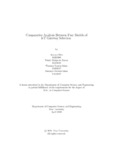Comparative analysis between four models of IoT gateway selection
Abstract
The “Internet of things” (IoT) is a leading sector of technology where usual analog
devices can be turned into smart devices with embedded systems and sensors. These
devices can communicate with each other without requiring any human to human
or human to computer interaction and automate various aspects of human lives.
With the growing application of IoT some of the crucial challenges faced in this
sector are maximizing throughput, minimizing energy consumption of the gateways
and balancing loads among the gateways efficiently. Not to mention providing high
throughput and low energy consumption at the same time is a contradictory concept
and the selection models have to reach the most optimum trade-o↵ point to o↵er
better performance. There are various models that have been proposed for IoT
gateway selection, each of which comes with various pros and cons. Hence we
decided to conduct a comparative analysis between a few of the most innovative
and promising Gateway Selection models to find out which of these models are
relatively more e↵ective to tackle the above-mentioned challenges in IoT. For our
research, Game Theory Gateway Selection (GTGWS), Taxi-Sharing, Floyd-Warshall
& Minimax (FWM) Algorithm and Evolved Reliability and Traffic-aware Gateway
Selection (ERTGS) model were studied. To ensure the credibility of this analysis the
models are tested under two distinguished network conditions - di↵erent ‘demand’ of
the end devices & di↵erent ‘number’ of end devices connected to the gateway. Under
the given scenarios, various data were obtained. For instance, given a least congested
network, bandwidth usage by these four models were: ERTGS utilizes 30.464%,
Taxi-Sharing utilizes 15.25%, FWM utilizes 12.5% and GTGWS uses 21.68% of
the total bandwidth. Various results like these were obtained for other evaluation
criteria such as load di↵erence and energy consumption; after careful analysis it was
found that none of the four models o↵ers optimal solutions to all of the challenges;
and that di↵erent models are better suited for di↵erent network priorities which are
discussed in details in this paper.

